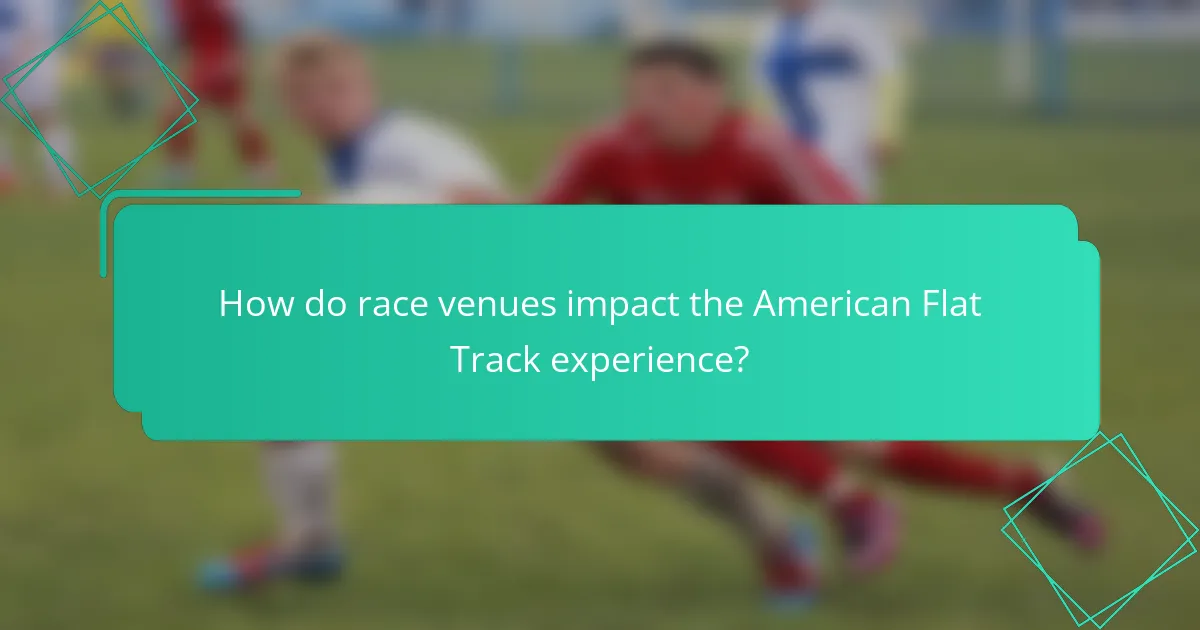American Flat Track racing captivates fans with its thrilling events and competitive spirit. The 2025 race schedule features iconic venues like Daytona TT and Sacramento Mile. Each venue presents unique challenges for top competitors, including Indian Motorcycle and Harley-Davidson. This article explores the race schedule, venues, and the dynamics of the competitors in this exciting motorsport.

What are the key events in the 2025 American Flat Track race schedule?
The key events in the 2025 American Flat Track race schedule include a series of races across various iconic venues. Notable events are the Daytona TT, the Sacramento Mile, and the Springfield Mile. Each venue offers unique challenges and attracts top competitors. The season features a mix of short tracks and half miles, enhancing the competitive landscape.
How do race dates vary across different regions?
Race dates for American Flat Track vary significantly by region due to local scheduling and climate considerations. The season typically runs from March to November, with northern venues often hosting events earlier or later than southern ones. Regional events may also coincide with local festivals, impacting scheduling. For example, races in warmer climates may be more frequent during summer months, while colder regions often have fewer events in early spring or late fall.
Which venues host the most popular races?
The most popular races in American Flat Track are hosted at venues like Daytona International Speedway, the Indiana State Fairgrounds, and the Santa Rosa Fairgrounds. These locations are known for their rich racing history and enthusiastic crowds. Daytona International Speedway is especially notable for its large attendance and iconic status in motorsports. The Indiana State Fairgrounds features a unique dirt track that attracts top competitors. Santa Rosa Fairgrounds offers a scenic setting that enhances the racing experience.
What are the major changes in the schedule compared to previous years?
The major changes in the American Flat Track schedule compared to previous years include an increase in race venues and a restructured calendar. This year, the series features 18 races across 11 states, expanding from last year’s 16 races in 10 states. Additionally, several iconic tracks have been added, enhancing the variety of racing experiences for competitors and fans alike. The changes aim to improve audience engagement and showcase diverse racing conditions.

How do race venues impact the American Flat Track experience?
Race venues significantly enhance the American Flat Track experience by providing unique atmospheres and varying track conditions. Each venue contributes distinct characteristics, influencing race strategies and rider performances. For instance, tracks like the Daytona Flat Track offer a high-speed layout, while others may feature tighter turns and different surfaces, affecting handling and grip. Additionally, the local culture and fan engagement at each venue enrich the overall atmosphere, creating memorable experiences for attendees and competitors alike.
What are the characteristics of iconic American Flat Track venues?
Iconic American Flat Track venues feature unique characteristics that enhance the racing experience. These venues typically have a rich history, showcasing a blend of tradition and modernity. Many are known for their oval tracks, which vary in surface materials, often including dirt or clay. Spectator capacity is another key attribute, with some venues accommodating thousands of fans, creating an electric atmosphere. Additionally, the accessibility of these venues plays a crucial role, as they are often located near major cities, making them easy to reach for enthusiasts. Finally, the presence of amenities, such as hospitality suites and fan zones, enhances the overall experience for attendees.
How does venue location influence spectator attendance?
Venue location significantly impacts spectator attendance by affecting accessibility, local interest, and event atmosphere. Proximity to urban centres often leads to higher turnout due to easier access. Additionally, venues in regions with a strong motorsport culture attract more fans. Seasonal weather conditions can also influence attendance, with favourable climates boosting spectator numbers. Ultimately, the combination of these factors shapes the overall success of American Flat Track events.
Which venues have hosted American Flat Track races for the longest time?
The venues that have hosted American Flat Track races for the longest time include the Springfield Mile and the Daytona International Speedway. Springfield has been a staple since the series’ inception, while Daytona has hosted races for several decades, showcasing the sport’s rich history. Other notable long-standing venues include the Indianapolis Motor Speedway and the Santa Rosa Fairgrounds, both integral to the series’ legacy.

Who are the top competitors in American Flat Track racing?
The top competitors in American Flat Track racing include Indian Motorcycle, Harley-Davidson, and KTM. Indian Motorcycle has dominated recent seasons, showcasing strong rider talent and innovative technology. Harley-Davidson remains a historic and competitive presence, while KTM has made strides in performance and design. Other notable competitors include Yamaha and Suzuki, contributing to a diverse and competitive field.
What distinguishes leading riders from emerging talents?
Leading riders excel due to experience, skill, and adaptability, while emerging talents show potential but lack consistency.
Leading riders often have a deep understanding of race strategies and conditions, allowing them to navigate challenges effectively. They typically have years of competitive experience, which sharpens their decision-making skills. In contrast, emerging talents may possess raw speed and talent but often struggle with race-day pressures and tactical nuances.
Additionally, leading riders usually have established support networks, including sponsors and teams, which provide resources and guidance. Emerging talents may still be building these relationships, impacting their overall performance.
The gap in performance can also be attributed to the unique attributes of leading riders, such as their ability to maintain composure under pressure and their refined technical skills.
How do competitors prepare for the unique challenges of different tracks?
Competitors prepare for unique track challenges by adapting their strategies and equipment. Each venue presents distinct surface conditions and layouts that influence bike setup and riding style. For example, dirt tracks require specific tire choices for optimal grip, while asphalt tracks demand different handling characteristics. Competitors analyse track data and past performances to refine their approaches, ensuring they are prepared for variations in weather and track conditions. This adaptability is crucial for success in American Flat Track events.
Which competitors have achieved the most wins in recent seasons?
In recent seasons, the top competitors in American Flat Track include Jared Mees, Briar Bauman, and Brandon Robinson. Jared Mees has consistently dominated, securing multiple championships. Briar Bauman and Brandon Robinson have also achieved significant wins, showcasing their competitive edge. Their performances highlight the intense rivalry and skill within the sport.

What are the unique attributes of American Flat Track racing?
American Flat Track racing features unique attributes that distinguish it from other motorsport events. Key aspects include the distinctive oval dirt tracks, diverse motorcycle classes, and a rich history dating back to the early 20th century. The racing format emphasises both speed and skill, with competitors navigating tight turns and varying track conditions. Additionally, the community atmosphere and fan engagement during events create a unique racing culture.
How does the motorcycle setup differ for various track types?
Motorcycle setups vary significantly across track types to optimise performance. American Flat Track requires specific adjustments based on track surface and layout.
For example, on a dirt track, riders use softer suspension settings to absorb bumps, while on a paved track, firmer settings enhance stability and cornering. Tire selection also differs; dirt tracks favour knobby tires for traction, whereas slicks are preferred for paved surfaces.
Additionally, gearing adjustments are crucial; shorter gearing benefits acceleration on tight tracks, while longer gearing aids top speed on expansive circuits. Each setup caters to unique track characteristics, enhancing rider control and speed.
What role does the motorcycle brand play in a competitor’s success?
The motorcycle brand significantly influences a competitor’s success by shaping performance, brand loyalty, and market visibility. Brands like Harley-Davidson or Indian Motorcycle enhance rider experience through advanced technology and heritage, attracting dedicated fan bases. This loyalty can translate into higher sales and sponsorship opportunities, impacting overall competition dynamics. Additionally, strong brand presence at American Flat Track events elevates visibility for both the brand and its competitors, fostering a competitive environment that drives innovation and performance improvements.

What are the challenges faced by American Flat Track competitors?
American Flat Track competitors face challenges such as intense physical demands, financial constraints, and competition from various racing styles. The sport requires high skill levels and mental resilience to navigate tight tracks and unpredictable weather conditions. Additionally, securing sponsorships and managing travel expenses can strain resources. The unique attribute of American Flat Track is its blend of speed and technical riding, which demands constant adaptation and focus from racers.
How do weather conditions affect race outcomes?
Weather conditions significantly influence race outcomes in American Flat Track events. Factors such as temperature, humidity, and precipitation can affect track surface conditions and rider performance.
For instance, high humidity can lead to a slippery track, impacting grip and control. Rain can create hazardous conditions, often resulting in delays or cancellations. Conversely, warm, dry weather typically provides optimal racing conditions, enhancing speed and safety.
Riders must adapt their strategies based on these conditions, which can lead to unexpected results. For example, a rider skilled in wet conditions might outperform others in rain, showcasing the unique attribute of adaptability in racing.
Overall, understanding weather impacts is crucial for competitors and teams when preparing for events.
What are common injuries sustained during races?
Common injuries during American Flat Track races include fractures, abrasions, and concussions. These injuries often result from falls, collisions, or high-speed crashes. Fractures usually affect the arms, legs, and collarbones, while abrasions can occur on exposed skin. Concussions are a serious concern due to the risk of head impacts. Proper protective gear can mitigate these risks but does not eliminate them entirely.

How do fans engage with American Flat Track racing?
Fans engage with American Flat Track racing through live attendance, social media interaction, and merchandise purchases. These activities enhance their connection to the sport and its community.
Live events attract thousands, showcasing thrilling races at diverse venues across the country. Fans often share their experiences online, discussing race outcomes, favourite competitors, and upcoming events. Merchandise sales, including apparel and memorabilia, allow fans to express their support and loyalty to teams and riders.
Overall, the engagement fosters a vibrant community around American Flat Track racing, ensuring its growth and popularity.
What are popular ways for fans to follow races live?
Fans can follow American Flat Track races live through several popular methods. These include official live streaming services, social media updates, and in-person attendance at race venues.
Official live streaming platforms provide real-time coverage of events, allowing fans to watch races from anywhere. Social media channels offer live updates, race highlights, and interaction with other fans. Attending races in person gives fans the full experience of the atmosphere and excitement.
Additionally, mobile apps dedicated to American Flat Track can send notifications about race schedules and results, keeping fans engaged and informed. These methods collectively enhance the race-following experience for enthusiasts.
How do social media platforms enhance fan interaction?
Social media platforms enhance fan interaction by providing real-time updates, fostering community engagement, and facilitating direct communication between fans and competitors. These platforms allow fans to follow American Flat Track events closely, share experiences, and connect with fellow enthusiasts. Additionally, athletes can leverage these channels to share insights, behind-the-scenes content, and personal stories, enriching the fan experience. Enhanced interaction leads to increased loyalty and participation in events.

What best practices can enhance the American Flat Track racing experience for fans?
To enhance the American Flat Track racing experience for fans, focus on interactive engagement and accessibility. Implementing fan zones with activities, meet-and-greets with competitors, and live Q&A sessions can create a vibrant atmosphere. Offering mobile apps for real-time updates and race statistics enhances convenience. Additionally, providing diverse food options and merchandise stalls at venues enriches the overall experience. Engaging with fans through social media before and after events fosters community and excitement.


